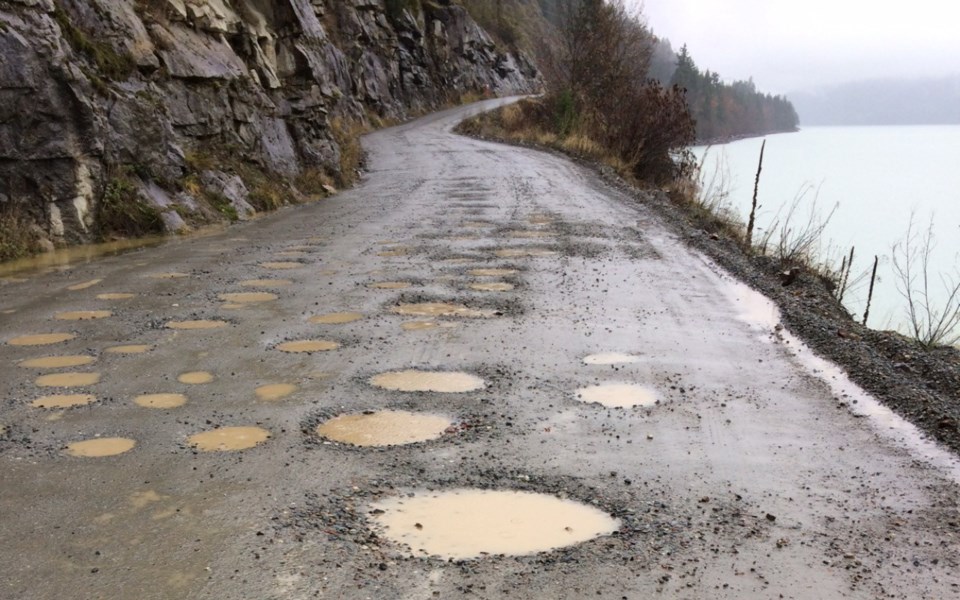The latest bout of bad weather has hurt the quality of the In-SHUCK-ch Forest Service Road, and locals are once again calling around looking for answers. The solution to their problem won't be solved by another pass of a grader though. Instead, Douglas First Nations Chief Don Harris is considering a different approach.
"It needs to become a public road because there's so much use," said Harris. "Heather Jean (Properties) are growing there. First Nations communities down there are growing as well, and the industry is slowing down. I know the Ministry of Forestry gives us a little bit of maintenance dollars on an annual basis, but it's not near enough to cover it."
In 2013 (the first year road usage numbers are available), just over 60,000 people drove the In-SHUCK-ch service road. Last year, that number was up to over 101,000. Thanks to increased traffic from people going hunting, camping or using the hot springs, the road gets worn down more quickly.
"We've dealt with this road for years, it's increasingly busier, it's probably one of the busiest forest service roads in the province," said Paul Palmer, a resident of Lillooet Lake Estates. "And because it's so busy it gets beat up. The traffic causes a lot of the wear and tear on it."
In response, the Ministry of Forests, Lands, Natural Resource Operations and Rural Development noted that Sea to Sky Natural Resource District has seen small increases in funding over the past several years.
According to the Ministry, approximately 80 per cent of the district's budget for road maintenance is spent on the In-SHUCK-ch and Lillooet West forest service roads.
On top of yearly maintenance, since 2011, road and bridge infrastructure upgrades on In-SHUCK-ch Forest Service Road total more than $5.1 million, with $934,000 being spent in the last two years. An additional $178,000 was recently spent to upgrade a flooded section at the 43-kilometre mark, finishing an effort to raise all the areas of the road that have historically flooded during high rainfall.
Lizzie Bay Logging, currently holds the road maintenance contract for the In-SHUCK-ch. It goes up for bid every three years. Operations Manager Gord Menzel believes the value of the bid was around $250,000. But, he says, that money that can get used up fast when working on a road that twists over 80 km through the mountains.
"That has to cover all the snow removal, all the sanding, all the brushing and replace guard rails on bridges," explained Menzel.
"The snow plowing alone will be anywhere from $80,000 to $100,000 dollars a year. To do one bridge, those are about $8,000 a bridge, Brushing, I can burn up $20,000, $30,000, $40,000 dollars in brushing in no time. Then you throw two graders out there or a water truck in the summer when it's too dusty; I can spend $200,000 in a month."
Harris says Douglas First Nation is considering an application to the courts to have the road placed under Ministry of Transportation jurisdiction. The inspiration for the idea came from the Douglas Trail/Highline Road ruling made a few years back.
Deemed a hydro access road for many years, the road was declared public after Wolfgang Skutnik brought action against the province. Justice Loryl D. Russell ruled the road had received significant public funding to maintain the road, and it was an essential access route to nearby communities for local residents.
Without taking legal action, Harris speculated it could take years to get the road up to a standard that the Ministry of Transportation would take over.
In an email, the Ministry of Transportation said, "they are not considering taking over the road at this time. Generally speaking, however, the road would need to meet ministry standards, which are based on Transportation Association of Canada specifications."
Substantial upgrades to the road were included as part of past treaty negotiations with the In-SHUCK-ch Nation, but negotiations fell through. A recent study completed in 2016 by the province and the First Nations estimated turning the road into a two-lane paved highway would cost $390 to $500 million.
This year, the road had been in relatively good condition up until the last few weeks. Heavy precipitation and on-and-off freezing over the past month have led to soft shoulders and potholes.
On its website, the Ministry of Forests put a caution in place about In-SHUCK-ch road for Nov. 23 until further notice, warning of possible slides and localized floods.




